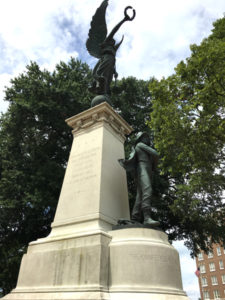
By Steve Brawner
One thing about the past – it changes as much as the present.
That’s because the lenses through which we view the past are ever changing, which brings us to the Confederacy and the ways Arkansas memorializes it.
The State Capitol grounds are home to 15 monuments, and three of them relate to the Confederacy. The Monument to Confederate Soldiers, dedicated in 1905, and the Monument to Confederate Women, dedicated in 1913, are at the front corners of the Capitol and are the tallest statues on the grounds. A third monument, the War Prisoners’ Marker, would be easy to miss, as it’s basically a raised plaque near the spot where the 10 Commandments monument will be rebuilt.
Similar monuments have been sources of major controversy in recent months elsewhere. The deadly clash in Charlottesville, Virginia, on Aug. 12 occurred after white nationalists protested the planned removal of a statue of Gen. Robert E. Lee. On Wednesday the city draped that statue and one of Gen. Stonewall Jackson in black shrouds. Four Confederate monuments in New Orleans were removed earlier this year. This past week, the University of Texas at Austin removed all Confederate statues on campus in the dead of night.
Arkansas has yet to see a widespread public outcry about its monuments and may not. Most have never attracted much attention. The Democratic Party of Arkansas called for the removal of Confederate monuments in a press release Aug. 17 but hasn’t said much since. Its political thinkers must know it won’t gain seats in Arkansas picking that fight. Gov. Asa Hutchinson said last week he opposes removing monuments, arguing that history should be learned from, not erased. He has already had one difficult fight this year related to the Confederacy – the separation of the days honoring Martin Luther King and Lee that he led – and he surely doesn’t want another.
What lessons can we learn?
It is true that we must learn from history, but what history are the monuments teaching? The ones at the Capitol make no mention of the Civil War’s causes and contexts. They were erected by Confederate-honoring organizations and clearly are sympathetic to the Confederate cause. The Monument to Confederate Soldiers is inscribed with the following words: “Our furled banner wreathed with glory, and though conquered we adore it. Weep for those who fell before it. Pardon those who trailed and tore it.” The Monument to Confederate Women features a mother and two children saying goodbye to a father leaving to join the war. The War Prisoners’ Marker memorializes a site where both Confederate and Union soldiers were held prisoner, but the plaque goes on to say its purpose is to remember the Confederates. At the same time, it also features a small engraving of an American flag.
If a controversy over these and other Confederate monuments does flare up, what should happen next? Tear down the statues? Continue to ignore them? Or somehow add some historical context with an admission of slavery’s wrongs? It might be easiest just to build more monuments. A good start was “Testament,” which was dedicated in 2005 to honor the nine students who integrated Little Rock Central High School. Its location not far from the Monument to Confederate Soldiers, and in front of a replica of the Liberty Bell, symbolizes the state’s march through history.
Then there’s the one star on the Arkansas flag marking the state’s membership in the Confederacy. Does it depict history, as all the other stars on the flag do, or does it glorify the state’s participation in the lost cause?
The wrong conversation
If monuments and flags are all we’re discussing, then we’re having the wrong conversation about the Confederate era. What matters is the lens through which we see the past. Two widespread mistaken beliefs must change. One is that slavery was not the principle cause of the war. The other is that “we” lost.
It was, and we didn’t. Freedom won, and people of all races are today’s beneficiaries.
Those myths – they’re what really should be torn down.
Related: Three kinds of racism.
© 2017 by Steve Brawner Communications, Inc.
Amen!
Once again, Steve, you have hit the nail squarely upon the head.
I read recently that around 95% of confederate soldiers were not slave owners. Can anyone verify?
Great last paragraph, Steve …
Thanks, Ken, Brent, and Lance.
J.C., if anything, that almost sounds low. I would think that virtually every Confederate soldier on the front lines was not a slave owner. The slave owners were in the back, or at home.
This is a great article, Steve. Thanks again for speaking out with the truth.
Nice Steve, people need to accept the reality that the Civil War was ultimately about slavery… as many Confederate leaders at the time said quite forthrightly. We’ve got to come to grips with our history.
Well said!!!!
Keep preaching this message!!!
Well said, Steve. What’s most important is our present behavior. We’re virtually unanimous that we’ve turned a page and need to march hand in hand toward a future of acceptance and mutual respect.
You won’t find any statues fashion and raised to George Washington in England. To them he was a traitor guilty of treason. I understand that.
White advantage is the only justification I can find for southern Americans doing such a ridiculous thing in the early and mid twentieth century. It’s also the reason that many don’t want them taken down.
Thank God though that we are at the point of having this discussion. This means that there is a critical mass developing of those who are willing and confident enough, as whites, to compete with the rest of Americans laying aside their traditional race-based advantages.
Thank you for this article. It’s right on!
Thanks, Sandy, Doug and Frances.